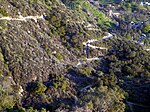Mount Lowe Railway

The Mount Lowe Railway was the third in a series of scenic mountain railroads in the United States created as a tourist attraction on Echo Mountain and Mount Lowe, north of Los Angeles, California. The railway, originally incorporated by Thaddeus S. C. Lowe as the Pasadena and Mt. Wilson Railroad Co., existed from 1893 until its official abandonment in 1938, and was the only scenic mountain, electric traction (overhead electric trolley) railroad ever built in the United States. Lowe's partner and engineer was David J. Macpherson, a civil engineer graduate of Cornell University. The Mount Lowe Railway was a fulfillment of 19th century Pasadenans' desire to have a scenic mountain railroad to the crest of the San Gabriel Mountains. The Railway opened on July 4, 1893, and consisted of nearly seven miles (11 km) of track starting in Altadena, California, at a station called Mountain Junction. Atop Echo Mountain was a 70-room Victorian hotel, the Echo Mountain House. A short distance away stood the 40-room Echo Chalet, which was ready for opening day. Other buildings on Echo Mountain included an astronomical observatory, car barns, dormitories, repair facilities, a casino and dance hall, and a menagerie of local fauna.For the seven years during which Lowe owned and operated the railway, it was not financially successful, and was eventually sold. A series of natural disasters destroyed the facilities, the first of which was a kitchen fire that destroyed the Echo Mountain House in 1900. Further fires and floods eventually destroyed any remaining facilities, and the railway was officially abandoned in 1938 after a flood washed railway property off the mountain sides. The ruins of Mount Lowe Railway remain. It was placed on the National Register of Historic Places on January 6, 1993, a listing that was enlarged in January 2015.
Excerpt from the Wikipedia article Mount Lowe Railway (License: CC BY-SA 3.0, Authors, Images).Mount Lowe Railway
Lower Sam Merrill Trail,
Geographical coordinates (GPS) Address Nearby Places Show on map
Geographical coordinates (GPS)
| Latitude | Longitude |
|---|---|
| N 34.211111111111 ° | E -118.12055555556 ° |
Address
Echo Mountain House
Lower Sam Merrill Trail
91001
California, United States
Open on Google Maps










